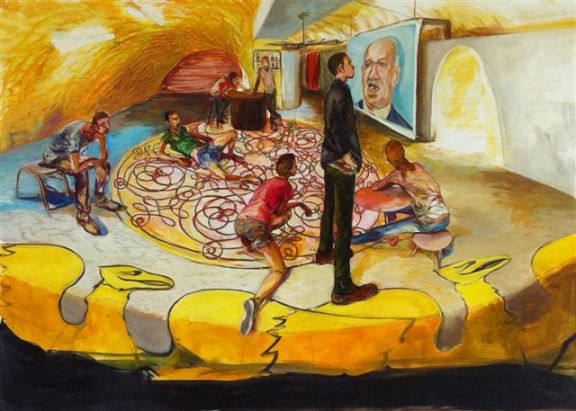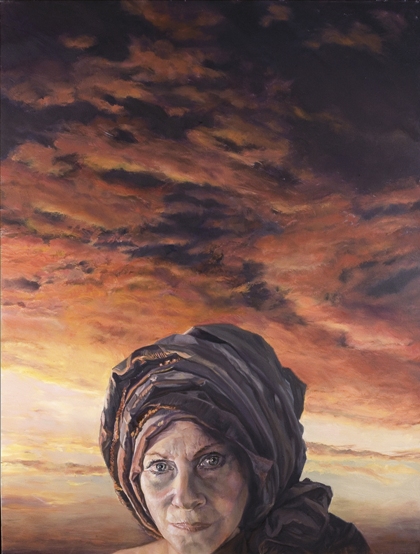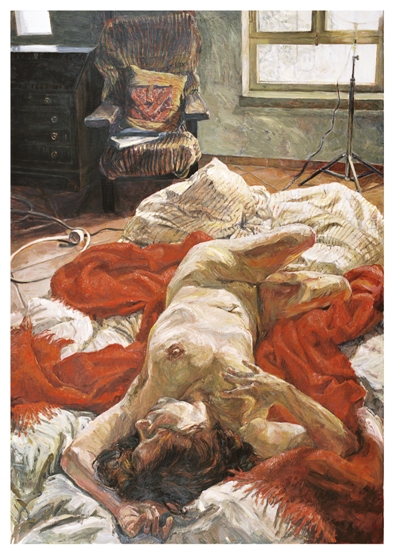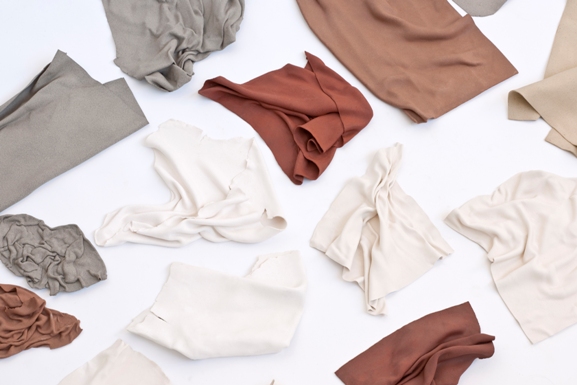
I entered a painting exhibition by Alma Itzhaky (b. 1984, an honors graduate from the Midrasha School of Art,) most curious to find out why she, out of a long list of hopefuls, was awarded the 2012 Osnat Mozes Prize for a Promising Young Artist. I found the answer easily enough. Plainly put, it lies in her ability to express what it feels like to be young, awash with emotions. And then, also, her approach to painting is youthful and uninhibited. She is not weighed down by the history of art but instead roams happily within a single work from one style to the next, creating scenarios which mix the real with the surreal.
Itzhaky only occasionally depicts moments of happiness. We see it in her painting of two young men lying of a rug in a field, playing chess, their figures bathed in a golden hue. But mostly she conveys negative emotions, portraying young people who seem bored, depressed and unable to break out of a stifling environment.
The title given her show is Living Room – designating a place or space where people congregate or just hang out, maybe in some sort of commune. There is mystery here; we are not told by the artist who these people are, or why they have come together.
Thinking about the Government is perhaps her most memorable piece. The setting is a brightly colored cave inhabited by a group of young people. One stands, others sit on stools or lounge on the floor. There appears to be no communication between them. It is not clear whether they are looking at the TV screen were Bibi is pontificating, or just staring out into space. The floor is actually a circular platform patterned with yellow camels – a sort of local merry-go-round perhaps? The overall impression, well portrayed, is of people living in a world of their own – the world of youth.

The onset of old age is the theme of Shirley Factor’ new collection of outsize realistic paintings dating from the past 13 years. This is not the work of an artist at the start of her career, but one with considerable experience, who has exhibited extensively and taught drawing at the Bezalel Academy of Arts and Design for many years.
Presiding over this show are two mesmeric self-portraits in which Faktor’s face is depicted against a fiery red sky (or in the second version – against blue and grey storm clouds.) Her head is swathed in turban. She looks out impassively at the viewer; a Delphian oracle waiting to be consulted or, in this instance, to receive compliments.
And compliments there are. Huge close ups of puffed, veined hands, and nails like claws are the subject of one set of unforgettable paintings. Opposite them hang outsize depictions of withered blood-red roses, disturbing images that connect back to 17th century Dutch still life Vanitas paintings in which overblown flowers, among other objects like skulls and a snuffed out candle, referred to approaching mortality.

Central to this exhibition are Faktor’s outsize portraits of her own nude body, detailed with shocking honesty. Some of the renderings, through the pose of the body or the color palette employed, recall paintings of less than beautiful people by English artist Lucian Freud. But, Faktor goes further. Juxtaposing ageing flesh with colored blankets or richly patterned coverlets, she made me think of Matisse’s paintings of voluptuous odalisques in a brightly patterned setting. Perhaps this is Faktor’s intent, the decorative elements introduced into her somber imagery serving as a reminder of youthful, feminine beauty.

SCULPTOR and Ceramist Daniella Yaniv Richter presents her latest collection of sculpted clay objects under the title Natural Process. In the past these have been realistic replications of everyday objects and items from Nature such as branches and stones. Attesting to this source is the small cluster of shell or flower –like shapes located in a corner of the gallery. But her main offering, displayed on a low platform, are a variety of abstract objects, all fashioned from clay. Coloring them white, beige or brown, she has simulated the appearance of different materials and textures. Some pieces look as if they were made from suede, others from cotton or cardboard. These effects reached by flattening, raising, crumpling or twisting the clay constitute a virtuoso performance by Richter in the handling of her medium.

ARI FISHER, a recent graduate of Bezalel’s Glass and Ceramics department, holds our attention with his first solo show. Titled Arbeit no. II, it is held under the auspices of the Nidbach series that showcases emerging talent.
His central installation is a ceiling-to-floor wooden scaffolding that recalls photos of concentration camp interiors. Shown alongside, are small cardboard models of well known European buildings, among them the windowless exterior of the gas chamber at Auschwitz-Birkenau -known today as Krema II; and the Bankside Power Station on the South Bank of the Thames, now housing Tate Modern. By way of these and other structures Fisher explores the significance of designs that espoused function and the work ethic over form and ornament, principles related to European architecture of the 1920s and 30s and, in particular, to the Bauhaus School of design.
Artists House, Jerusalem, 12 Shmuel Hanagid, Jerusalem. Tel: 02–6253653. Till December 8th 2012.





